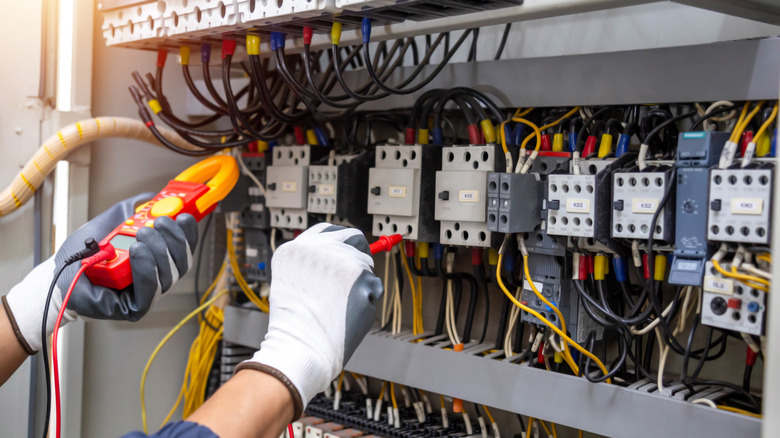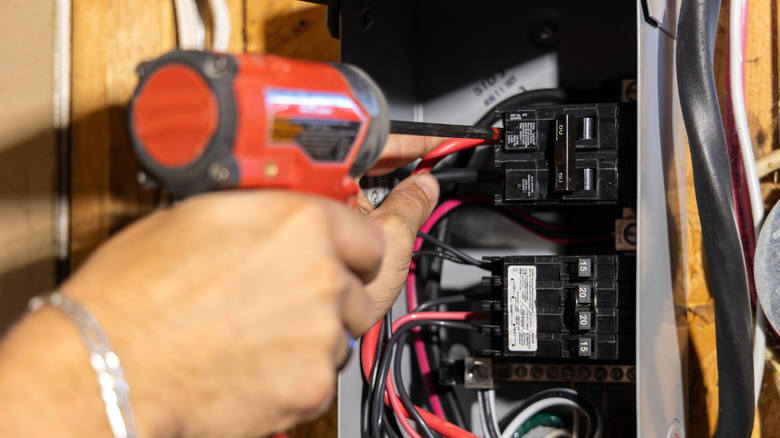Why Your Circuit Breaker Keeps Tripping (And How To Replace It)
Nobody looks forward to a power outage. After all, we rely on electricity to power appliances. And when there is a blackout, the situation can move from a minor to a stressful one quite easily. That said, if you're running your microwave and turn on the air fryer, and the power suddenly cuts out, it means that there's a fault somewhere in your electrical setup that needs your attention. The most common culprit? A tripping circuit breaker.
I've dealt with my share of tripping circuit breakers, be it at my friend's place or my home. And between fixing a kitchen that has lost power or a garage outlet that has gone dark because I plugged in too many appliances, I've learned a few things about circuit breakers the hard way. First and foremost, from my experience, a breaker tripping once or twice is quite common. In fact, I've often attributed it to a temporary overload or a minor issue.
However, if your circuit breaker is tripping frequently — say several times in a day — that's not a random glitch, and you should have it checked. There are a host of reasons as to why your circuit breaker (not the fuse box — there is a difference) might be tripping. Perhaps you've got too many appliances jostling for power on a single circuit simultaneously. Or maybe you've aging wires or a failing breaker that needs replacement.
For many, fixing this issue might seem like a job for a professional electrician beacuse electricity can be so dangerous to work with. But you'll be surprised to learn that it's something you can fix yourself if you know what to look for.
Common reasons a circuit breaker will keep tripping
If your circuit breaker trips, you shouldn't panic or ignore it, but instead hone in on the exact cause and respond quickly. One common explanation for why your circuit breaker keeps tripping is an overloaded circuit. You might not think of it, but plugging many devices into a single circuit could be a recipe for an overload.
For instance, if you hook major appliances into the same kitchen circuit and run them simultaneously, at best, you risk blowing up the fuse or tripping the circuit breaker. There's also a great chance that wires will overheat and probably cause a fire. That's why you should avoid plugging some appliances into an extension cord.
Have you ever heard that dramatic pop from your electric panel just before your lights go out? That might be a short circuit. It's more serious and mainly happens when a live wire touches a neutral one, creating a sudden surge in current that trips the circuit breaker immediately. A word of caution: this is not a simple DIY fix. You should shut off the power and contact a licensed electrician if there are telltale signs of a short circuit, such as burnt smells and charred outlet marks.
How to safely replace a circuit breaker
Just like wires, circuit breakers have their expiry date and will wear out. And if yours is tripping frequently, especially when the loads are low, the breaker might be the issue. The good news? Replacing a circuit breaker is something you can DIY — but only if you have proper electrical knowledge.
If you want to install a new circuit breaker, you'll first need to turn off the main power and verify that the power is off by using a voltage tester. Remember, fiddling with wires and electrical panels comes with risks. You can expose yourself to an injury or death from an electrical fire or shock. Once you're certain that no current is flowing, remove the panel cover, and use the voltage tester to touch every mounting screw and wire to make sure that there is no current flowing through the wires.
Next, gently remove the faulty breaker from the bus bar (they usually snap in). If there are wires connected to the breaker, disconnect them from the terminal and label them accordingly. You can even take a photo so you can recall their positioning. Before installing the new breaker, ensure it matches the old one's amperage rating, type, and brand. Otherwise, an incompatible breaker might fail to trip when a short circuit or an overload occurs, potentially leading to fires or electrical damage. After that, attach the new circuit breaker to the bus bar and replace the panel cover.
With the new breaker installed, go ahead and turn the power on again, then check the circuit breaker to ensure it's holding steady and not tripping under normal load. It's not a difficult process if you know what you're doing, but it is incredibly dangerous if you don't, so remember to always call a licensed electrician if you aren't completely certain you can do it on your own.


